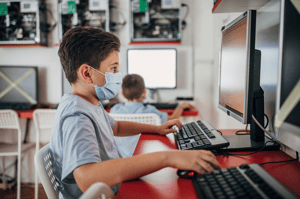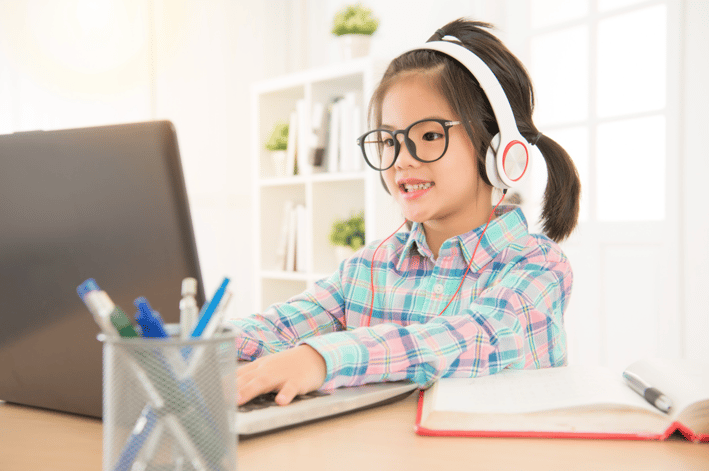A focus on social-emotional learning (SEL) allows educators to impact student outcomes associated with five key attributes: self-awareness, self-management, social awareness, relationship skills, and responsible decision-making. Research shows that students with stronger SEL skills perform better academically and are more successful when facing adversity both during school years and later in life.
Music-based techniques can help teachers introduce and improve SEL in the classroom setting, both in person and from a distance. Through music, students can boost their understanding of themselves and the world around them, and learn how to respond to conflict and challenges. Below are four ways that music can boost well-being with examples and ideas on how to easily include them into daily instruction.
Improve Cognitive Performance While Intrinsically Motivating Students
MRI scans reveal that multiple parts of the brain become active when people listen to music. Not only does active listening promote alertness and readiness to learn, but the very promise of getting to listen to music can also be beneficial.
A recent study by the National Academy of Sciences shows evidence that suggests when a musical event is promised as a reward, it inspires learning as much as other valuable rewards like food or money.
Music as a reward? What a welcomed innovation to the classroom! Imagine being able to offer music in place of candy, trinkets, or homework passes. Not only does this offer a healthy alternative, but it also puts in place a more intrinsic style of reward-based learning, furthering the goal of SEL and well-being that is so crucial when promoting the education of the whole student.
Look at Memorization in a New Way
From early grades when students learn body parts and directions with "The Hokey Pokey" to memorizing the names of all of the "Fifty Nifty United States," music plays an integral part in memorization. As adults, many of us can still recite facts we memorized with the help of music and savvy teachers. This is due mostly to how the brain responds to music and rhyme. Listening to music activates areas of the brain associated with memory, reasoning, speech, emotion, and reward simultaneously, allowing the brain to lay new memories more efficiently and provide for quick retrieval.
While memorization is never an ideal learning tool when used alone, there are some pedagogical needs when it comes to learning that students must memorize to be able to apply that knowledge down the road. Utilizing music for these scenarios will improve students’ ability to recall information and apply it to future critical thinking and evaluation. Use songs to introduce grammar or phonics concepts, math knowledge, or civics-related facts that can be accessed in future learning. Consider having students write their own songs, chants, or raps to engage their learning while collaborating with classmates and building relationships.
Build a Positive Classroom Community
Music has also been found to significantly improve student self-awareness and access to techniques for de-escalating stressful situations, all facets of a healthy classroom community. Using songs and activities to improve students' social-emotional intelligence can be achieved with just a few minutes a day.
One way to incorporate self-awareness content is through a music-based SEL program such as QuaverSEL. QuaverSEL takes the concept of storytelling and embeds it into songs, jingles, raps, chants, and other musical stories to teach young children about SEL content
 such as bullying, facing challenges, managing conflict, and other concepts that built a culture of community in K-5 classrooms. One teacher shared her experience saying, “My students and I were given the opportunity to learn more about one another through expressing our emotions with music, games, and interactive activities. It was a great opportunity and helped build a safe atmosphere for our classroom.” Teachers can access a free 30-day trial of the program.
such as bullying, facing challenges, managing conflict, and other concepts that built a culture of community in K-5 classrooms. One teacher shared her experience saying, “My students and I were given the opportunity to learn more about one another through expressing our emotions with music, games, and interactive activities. It was a great opportunity and helped build a safe atmosphere for our classroom.” Teachers can access a free 30-day trial of the program.Use Musical Brain Breaks to Improve Mood
Evidence has shown that music can produce healthy brain functions and overall feelings of well-being by activating several neurochemical systems, including those that produce feelings of pleasure and reduced stress. Music can create brain function changes by affecting neurochemicals such as dopamine, cortisol, serotonin, and oxytocin. For teachers, that means reducing disruptive behavior and promoting happier students who want to learn because they are cognitively equipped and prepared to do so.
Another way to bring music into the classroom is to incorporate brain breaks. This could mean playing "Freeze Dance" or similar activity style songs to get kids singing and moving. All students can benefit from engaging in simple physical tasks that cross the midline. When put to music, these activities prove challenging and mentally stimulating while giving them a break that they need to reinvigorate the mind with fresh oxygenated blood flow.
Using any or all of these strategies can foster self-awareness, social awareness, and relationship skills necessary for students to feel comfortable in their learning environments. Building a community of learners ready to learn and respect their teachers and peers doesn't happen overnight, but the foundation can be built in as little as five minutes a day when music is incorporated into the classroom.


